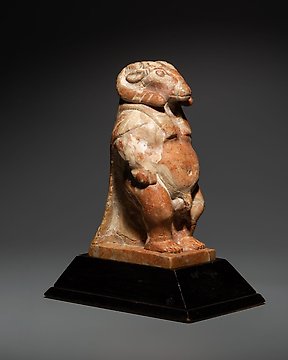
Oldtidens Egypt Stein Skulptur av Bes i panteistisk form som en apotropaisk gud. 12,2 cm H.
Nr. 83491265

Nr. 83491265

Spoon.
Ancient Egypt, Late Period, 664 - 323 BC.
Serpentine Stone.
Length 11.5 centimeters.
PROVENANCE: Private collection, Paris, France. Acquired in the 1980s.
CONDITION: Good condition.
Swimmer's spoons appear in the early 18th Dynasty, with the beginning of the New Empire; the earliest surviving example dates from the reign of Akhenaten, although the model probably dates even earlier. It remained in use for centuries, reaching into the early Christian period. There are also some surviving examples from the Sudan from the Napatean period (ca. 700-300 BC). It was a model that spread eastwards across the Mediterranean, as evidenced by a spoon of this type found in Cyprus, which is very close to Egyptian models. Generally polychrome, either by the application of paint or by the combination of materials, these pieces are made of wood, ivory, stone or even faience.
The girl who forms the handle, known generically as the swimmer, may have Egyptian or Nubian features, wears a wig and is always nude, although occasionally she is adorned with a necklace or a sash or belt. The pose is always identical, with her legs together and outstretched, her feet also outstretched and her arms facing forward, holding a bowl which may be rectangular, oval or cartridge-shaped, although on numerous occasions it will take the form of a water bird, often with the wings forming a lid. Other, rarer examples depict aquatic plants, fish or even an antelope (fig. 6). The spoons with simple bowls could be interpreted as depicting women carrying offerings. Among the second group, the most numerous are those in which the bowl takes the form of a duck or goose; in this case, the position of the arms suggests that the girl would not be swimming, but would be dragged over the water by the bird.
Traditionally these pieces were interpreted as cosmetic spoons, but as early as the 1960s Ingrid Wallert defined their use as ritual; they would have been used as ladles for libations or offerings or, in the case of those with lids, as containers for small quantities of myrrh or wine to be offered to the gods. They may also have been used to offer the deceased a type of secret ointment made in the temples, which ensured resurrection in the other world. This ritual interpretation is based both on texts and graphic representations and on the fact that most of them have been found in tombs, and not only of women, but also of men and children. Some fragments of these tools have also been found in houses and palaces, but none intact. This theory is also supported by the excellent state of preservation in which they have survived to the present day, despite being particularly fragile objects.
The fact that the swimmers' spoons belong to the sacred sphere, both in temples and in funerary contexts, is also supported by the ritual interpretation of the motifs. The formula in which the swimmer is carried by a goose, the most widespread, can be read as a hieroglyphic text alluding directly to the Beyond, since the hieroglyph of the goose can be read literally as the name of Geb, the god of the Earth. The girl would then be identified with his wife, Nut, the goddess of heaven, being carried by her husband across the eternal waters of the other world. Other such spoons have been associated with Hathor, the celestial deity and mother of the pharaohs, as well as a psychopomp goddess and therefore closely linked to funerary rituals. In the case of a spoon preserved in Moscow (fig. 8), a schematic representation of the god Bes, associated with music and dance, appears on the thigh of the young woman, sometimes tattooed on the thighs of musicians and dancers, possibly as a way of invoking his protection. On the other hand, the figure of the girl was in Egypt an emblem of youth and fertility, of vital energy, aspects of particular importance in the funerary sphere.
Notes:
- The piece includes authenticity certificate.
- The piece includes Spanish Export License (Passport for European Union) - If the piece is destined outside the European Union a substitution of the export permit should be requested, can take between 1-2 weeks maximum.
- The seller guarantees that he acquired this piece according to all national and international laws related to the ownership of cultural property. Provenance statement seen by Catawiki.
Hvordan kjøpe på Catawiki
1. Oppdag noe spesielt
2. Legg inn det høyeste budet
3. Å gjøre en sikker betaling